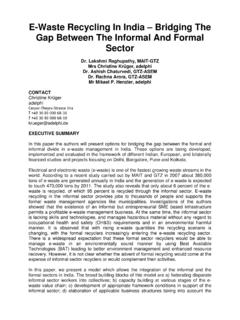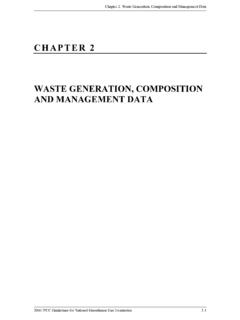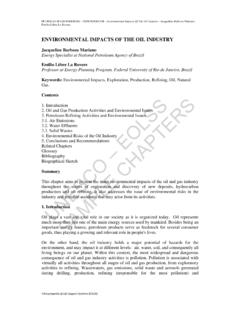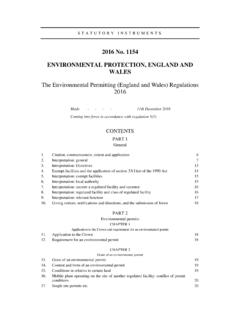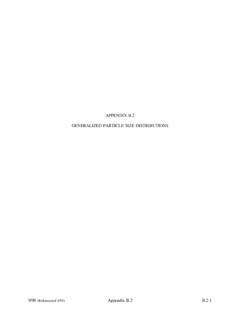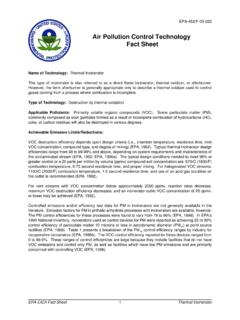Transcription of Municipal Solid Waste Performance Indicators - iswa.org
1 Municipal Solid Waste Performance Indicators Carlos Afonso Teixeira, University of Tr s-os-Montes and Alto Douro (UTAD). Eduarda Beja Neves, National Laboratory of Civil Engineering (LNEC). Contact Contact Name: Carlos Afonso Teixeira Organisation: Universidade de Tr s-os-Montes e Alto Douro Postal address: Quinta de Prados, 5000-801 Vila Real - Portugal Telephone: +351 259 350 236. Facsimile: +351 259 350 266. Email: EXECUTIVE SUMMARY. This paper introduces a framework developed for the Waste management sector supported by Performance Indicators . It was designed in order to be coherent and articulate and to enable full integration of its information. These Indicators proved to be a useful management tool.
2 This framework includes 167 Performance Indicators (PI) divided into two types of information: 58. Context Indicators which are important for a proper identification of the System's characteristics, and 109 Operational Performance Indicators which include staff information, physical Indicators , operational Indicators , quality of service Indicators , and financial and economical Indicators . In order to test applicability of the Performance Indicators Framework (PIF) it was implemented in a Waste Management System (WMS) in the Northern Region of Portugal. It proved to be a helpful tool in providing information about the global Performance of the WMS and the several Waste management components.
3 It provides efficiency assessment of the WMS, the quantification of its productivity, the identification and correction of anomalies. Another advantage of this management tool is the possibility to widen its use to other WMS in order to enable benchmarking policies. Recently the use of PI in the urban Waste sector gained an important international dimension, namely through the participation of LNEC and the Portuguese Regulator for water and urban Waste services (IRAR), in the COST Action C18 Performance Assessment of Urban Infrastructure Services: the case of water supply, wastewater and Solid Waste . INTRODUCTION. The challenges faced today by Solid Waste managing entities go beyond simple quantification and characterization of the collected wastes.
4 These challenges involve not only regulatory and law abiding but also global Performance assessment by quantification of the system's efficiency. Efficiency is measured in terms of achievement of management targets and resource optimization. The definition of a Performance Indicators Frameworks (PIF) can help verify the adequacy of management procedures, whether targets have been met or how far they are from being accomplished. PIF monitor services compliance with the scheduled activities and strategic goals by supporting decision makers with the analysis of updated information. PIF for WMS are useful tools for decision makers, managers and technicians dealing with complex situations which involve deciding, planning or acting (Ljunggren, 2000).
5 PIF aims to evaluate different alternatives that prove to be intelligible and consistent and also to evaluate the environmental, economic and social consequences of its implementation. Building PAF is followed by its implementation (Ljunggren, 2000). This stage involves several actors responsible for the various components of WMS: deposition, collection, transport, transfer, treatment and elimination. A strong participation is required to each of these actors in the development of the PIF. This active participation comprises data collection and treatment and the analysis of the Performance Indicators included in the PIF. The implementation of PIF's, whether for internal or external use requires adequate measuring procedures that ensure an uniform data collection and also a Performance assessment process based on clear definitions and common language.
6 These procedures can take the form of Indicators (Coelho and Alegre, 1999). The European Environment Agency (EEA, 1999) (EEA, 2003) defines an indicator as an elementary datum or a simple combination of data capable of measuring an observed phenomenon. Performance Indicators monitor the effect of policy measures. They indicate whether or not targets will be met, and communicate the need for additional measures. According to Beja Neves & Ant o da Silva (2000a) (2000b), Performance Indicators can quantify and qualify the level of quality of a service rendered by a WMS. A PI can evaluate simultaneously how efficiently the resources are put into use and how far the System is from achieving predefined management goals.
7 Each indicator reflects the Performance of the System, according to each management component and in a well defined period of time and area. This paper presents a set of Performance Indicators (PI) for Waste Management Systems. It was built in order to be coherent and articulate and allowing a full integrated analysis. For the current paper it was considered best to divide the PI into two major groups: context information and operational Performance information. The adopted set of PI includes 167 Indicators that evaluate environmental, social and economical aspects of WMS. It provides information about deposition, collection, transport, transfer and elimination technologies.
8 It also includes information about human and material resources and valorisation and elimination strategies. The framework assesses the consequences of political and technical decisions, reflecting collection, Waste recovery and market rates, and demonstrating potential fields of intervention. The framework is also capable of evaluating the need to introduce Waste reduction mechanisms. Several potential recipients can be identified at the national and international level. Municipalities, Associations of Municipalities, Waste Management Systems, Waste Regulator Institutes and the Ministry of the Environment constitute the first group. Organizations such as Eurostat, OECD and the European Commission constitute the latter.
9 METHODOLOGY. The Performance Assessment Framework was based on the Performance Indicators for Water Supply Services book, developed by the International Water Association (IWA) (Coelho and Alegre, 1999) (Alegre, 2000), taken to a broader perspective to the Solid Waste scope. These Indicators include two kinds of information: a) Context (58 Indicators ) - important for a proper identification of the System's characteristics, its Managing Entity and the geographical region where it is inserted. It allows an objective analysis of the PI's and enables an independent comparison with other System's;. b) Operational Performance (109 Indicators ) staff information, physical Indicators , operation Indicators , Indicators of the quality of service and financial and economical Indicators .
10 The scope of the proposed PIF is the Solid Waste Management System. These systems are considered open since they exchange energy, resources and financial flows through its frontier. Figure 1 shows a typical Waste Management System. After its deposition, Waste is collected, transported, transferred and eliminated inside the system's limits. In order to perform these operations there is a consumption of financial and energetic resources. The system produces raw materials (recycled products) liquid and gaseous emissions into the environment. Five factors were taken into account when creating this PIF: quantity, composition and sorting degree of the Solid Waste ; demand and market prices of the recycled materials; energetic consumption (electricity and fuel); technology and resources available; and legal and environmental constraints.
